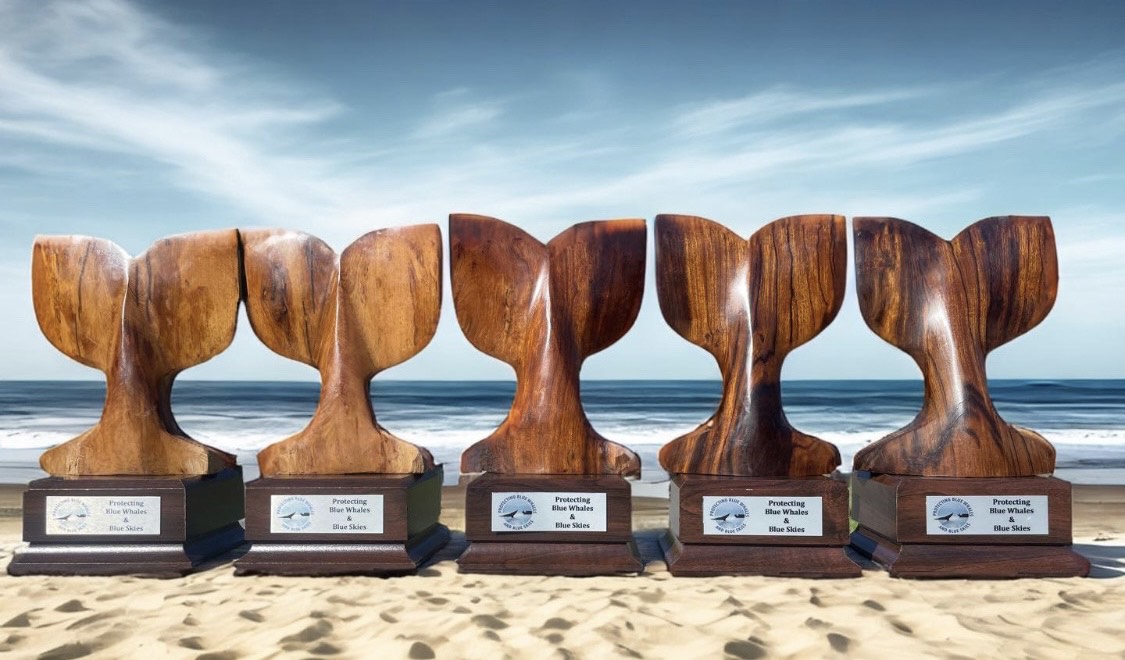VENTURA — Shipping companies received awards for reducing speeds in the 2023 “Protecting Blue Whales & Blue Skies” program. The voluntary incentive program ran May 1 through Dec. 15, 2023, to reduce fatal ship strikes to endangered whales, air pollution, regional greenhouse gas emissions and underwater noise.
Thirty-three shipping companies participated, transiting at 10 knots or less in the San Francisco and Monterey Bay and Southern California regions, including Ventura County. Cooperation levels continue to improve in both regions with an overall 81% cooperation rate from participants during the 2023 season, up from 78% in the 2022 season.The number of participants was also greater than any previous year, increasing from 23 shipping companies in 2022.
Shipping companies received recognition based on the percentage of distance traveled by their vessels through the Vessel Speed Reduction (VSR) zones at 10 knots or less.
The three award tiers are Sapphire (85-100% of fleet total distance in VSR zones traveled at 10 knots or less), Gold (60%-84%) and Blue Sky (35%-59%). Automatic Identification System (AIS) transponders on each ship transmit the ship’s speed and location. AIS data was analyzed for each fleet, and the company’s performance was classified by tier.
Thirteen companies reached the Sapphire level, the most in the top award level category since the program began. They are CMA CGM, CSL Group, D’Amico Tankers DAC, Hapag-Lloyd, Mediterranean Shipping Co. (MSC), NingBo Ocean Shipping Co., NYK Ro-Ro, Ocean Network Express (ONE), Orient Overseas Container Line (OOCL), OSG Ship Management, Swire Shipping, Yang Ming and Wallenius Wilhelmsen.
The French shipping line CMA CGM has improved its cooperation level year after year and achieved the highest cooperation level of any line in the 2023 season at 96% by transiting over 46,000 nautical miles at 10 knots or less in the VSR zones. Other Sapphire-level participants that have demonstrated increasing cooperation in recent years include MSC, NYK Ro-Ro, ONE, Wallenius Wilhelmsen and Yang Ming.
For the sixth year in a row, MSC, the world’s largest shipping line, notably achieved the Sapphire tier and demonstrated that advance planning enables ships to adjust their schedules to cooperate with the VSR program without disrupting operations. OOCL and Swire Shipping notably achieved a 95% cooperation level in both the 2022 and 2023 program seasons.
The 10-knot target complements the National Oceanic and Atmospheric Administration (NOAA), U.S. Coast Guard and Environmental Protection Agency voluntary requests for all vessels 300 gross tons or larger to reduce speeds during the months of peak air pollution and endangered blue, humpback and fin whale abundance to protect them from ship strikes.
Ship strikes are a major threat to whales globally and to the recovery of endangered blue, fin and humpback whales in California waters. Reducing the risk of ship strikes is a high priority for NOAA, including for NOAA’s West Coast national marine sanctuaries. From 2007-2022, observed and documented deaths off of California totaled 52 endangered whales. This is thought to represent only a small fraction of the total number of ship strikes taking place annually.
The timing of the program coincides with the season when ground-level ozone (smog) concentrations are typically high. The 10-knot target allows ships to travel at an efficient operating load using less fuel and producing less pollution and regional greenhouse gas emissions.
The program also has implemented an Ambassador Initiative for consumer goods companies that use participating shipping lines and for ports and logistics companies that work with the lines. Ambassadors encourage shipping industry cooperation by increasing the demand signal for sustainable shipping. Ambassadors also receive data on the reduced speed efforts of their shipping companies and the resulting decrease in air pollutants, greenhouse gasses, risk of ship strikes on endangered whales and ocean noise. This information can then be used to inform consumers purchasing their products and help Ambassadors make more sustainable shipping choices.
Protecting Blue Whales and Blue Skies is a collaborative effort by Ventura County Air Pollution Control District; Santa Barbara County Air Pollution Control District; San Luis Obispo County Air Pollution Control District; Monterey Bay Air Resources District; Bay Area Air Quality Management District; Channel Islands, Greater Farallones, Cordell Bank, and Monterey Bay national marine sanctuaries; The Volgenau Foundation; California Marine Sanctuary Foundation; National Marine Sanctuary Foundation; Greater Farallones Association; Environmental Defense Center; Point Blue Conservation Science; Starcrest Consulting; and Scripps Whale Acoustic Laboratory/Scripps Institution of Oceanography.
For more information, visit www.bluewhalesblueskies.org

